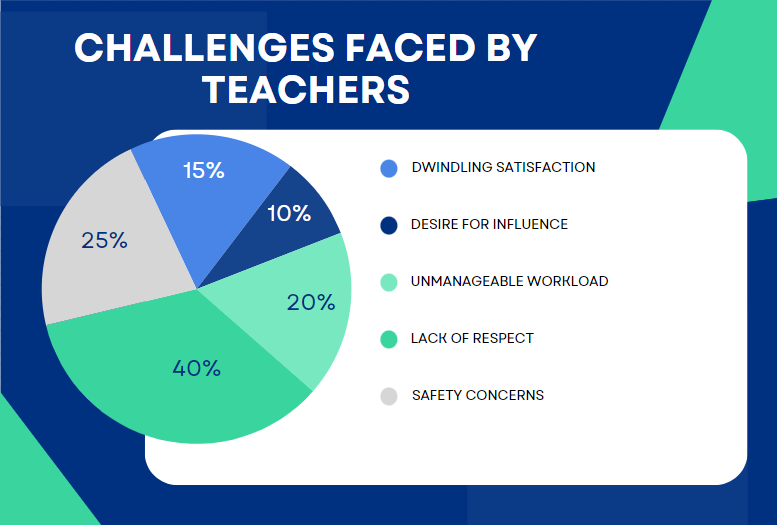Understanding the Causes
Why is Australia Facing a Teacher Shortage?

How did we arrive at the current predicament of a teacher shortage in Australia?
Is it due to inadequate compensation?
Contrary to common belief, Australian teachers are among the best-paid globally, ranking fifth in the OECD after Luxembourg, Germany, Canada, and the Netherlands, as reported by the Australian Financial Review.
Are career advancements and limited opportunities a contributing factor?
The federal government’s paper addressing the teacher shortage reveals minimal career prospects unless teachers ascend the bureaucratic ladder and assume high leadership roles.
However, such roles often draw the best educators away from direct student engagement, focusing instead on managerial responsibilities.
Has COVID-19 impacted the school environment?
According to an ABC article, The COVID-19 pandemic has exacerbated the teacher shortage crisis in Australia., placing extreme pressure on all facets of schooling.
The transition to online learning not only strained the existing teaching workforce with additional workloads but has also expedited the departure of some educators from the profession, intensifying the teacher shortage.
Moreover, the shift to home learning has magnified educational inequalities, as not all students had equal access to the necessary resources for effective online learning. This slowed down some learning progression in students for over a year and created greater disadvantages in certain states in Australia.
Is a teaching career and appealing career for young Australians?
The perception of schoolteachers as consistently stressed and at risk of burnout predates COVID-19. Teaching is inherently demanding, with challenges extending beyond teachers’ control, such as the diverse experiences students bring to the classroom.
The aspects within teachers’ control, like lesson preparation and effective classroom management, require extended hours, contributing to increased workload and stress. Teacher workload and stress levels have increasing significantly in recent years.
Statistics from the Australian Institute for Teaching and School Leadership reveal a significant increase in teachers leaving the profession, rising from 21% in 2020 to 35% in 2022. These stressful conditions have not only driven more teachers out of the workforce but have also deterred new students from pursuing education degrees.
The Impacts of the Teacher Shortage
Effects on Education and Students

Monash University has unveiled significant insights into the challenging environment within which teachers operate, shedding light on key concerns:
- Lack of Respect: A staggering 7 in 10 teachers admit to not feeling respected by the Australian public. This pervasive sentiment can undoubtedly influence their performance and job satisfaction.
- Safety Concerns: One in four teachers does not feel safe in their workplace, underscoring a serious issue that demands attention and resolution.
- Unmanageable Workload: Less than 14% of teachers report that their workload is manageable. This alarming statistic points to a systemic issue affecting the well-being and effectiveness of educators.
- Dwindling Satisfaction: The satisfaction levels among teachers have plummeted from 65.9% to 45.8% since 2019. Such a decline is concerning, especially considering the pivotal role teachers play in shaping the future through education.
- Desire for Influence: Teachers express a collective desire for a voice in policy-making, emphasizing the need for their perspectives to be considered in shaping the educational landscape.

The challenges extend beyond perceptions and opinions. The dissatisfaction among teachers, dipping below the 50% mark, is particularly troubling. Students thrive when guided by enthusiastic, motivated educators.
The teaching profession, ideally one of the most rewarding, seems to be facing a crisis in morale and job satisfaction. It begs the question: What factors within the schooling system contribute to these disheartening sentiments?
Urgent attention is required to identify and rectify the sources of dissatisfaction.
Adding to the complexity, rural and remote areas in Australia bear the brunt of a severe teacher shortage. While suburban areas face challenges, remote regions experience even greater difficulties due to a scarcity of educators. Larger class sizes are a direct consequence of the shortage, impacting the quality of education to these communities.
Furthermore, a notable disparity is observed in the valuation of teachers by the community. Only 38% of teachers say they feel valued by the community, a figure that contrasts starkly with international standards, as seen in Singapore, where 70% of teachers report feeling valued.
Teachers in Demand
The Urgent Need for Qualified Educators

Delving into the statistics reveals a concerning scenario for the future of secondary education in Australia. Currently, a substantial cohort of 27,000 secondary school teachers, aged between 55 and 64, is slated to retire in the next decade. This figure, when compared to the total employed count of 156,000, represents a significant percentage. As secondary school student enrolment experiences a steady 4% annual growth, the nation faces a demand surge requiring an additional 6,000 teachers to maintain equilibrium.
Considering the imminent retirement of 2,700 teachers annually over the next decade, the cumulative demand for new educators in 2024 alone stands at a staggering 8,700. However, the impending crisis intensifies when we scrutinize the number of aspiring teachers entering education programs. For the academic year 2024, a mere 2,000 university students have designated education as their top preference, with an additional 1,000 to 2,000 students listing it as their second or third preference.
Now, here lies the crux of the issue: the stark reality that approximately 50% of these aspiring teachers are likely to drop out before completing their degrees. This dropout rate raises a red flag, prompting the crucial question of why such a high percentage fails to persist in their educational journey.
The reasons behind this alarming trend are manifold. Many students discover that the practical aspects of teaching diverge significantly from their initial expectations. The weight of the course load proves overwhelming, the day-to-day challenges of managing a classroom can be a jarring revelation, and personal or financial factors may contribute to the decision to withdraw from their education degree.
Exploring the Numbers
Statistics and Trends of the Teacher Shortage

The teacher shortage issue appears to be exacerbated by a paradoxical situation. Despite schools expressing a desire to reduce class sizes for a more personalized teacher-student interaction, the statistics reveal an alarming trend. The number of students per teacher in Australia has increased from 14.9 to 16.1 in the past 10 years, indicating a contrary trajectory to the purported objective of enhancing individualized learning experiences.
Adding to the complexity of the problem, the New South Wales (NSW) Department of Education disclosed startling figures in October. These data indicate that a staggering 10,000 classes per day are inadequately staffed due to the prevailing teacher shortages. This deficiency represents a substantial impediment to the educational journey of students actively engaged in the learning process. The repercussions of missing out on classes due to a shortage of educators create a sense of disenchantment, leaving students and the education system short-changed.
Notably, the gravity of the situation is further underscored by recent data from the NSW Department of Education, revealing a concerning trend in the attrition of permanent teachers. In 2022, a staggering 1,854 permanent teachers resigned, marking a significant increase from the 929 reported in 2020. This surge in teacher departures poses a considerable challenge to the stability and continuity of education delivery, further amplifying the existing teacher shortage crisis.
Attracting Talent
Strategies to Encourage More People to Become Teachers

The findings from Melbourne University underscore a concerning lack of diversity within the teaching profession when juxtaposed with the broader Australian population. The data reveals stark disparities on multiple fronts, revealing a pressing need for greater inclusivity and representation.
Firstly, the statistics indicate that a mere one percent of teachers report a disability, a stark contrast to the national average of 18 percent among the broader population. This significant underrepresentation of teachers with disabilities suggests a potential oversight in cultivating a diverse and inclusive teaching workforce that reflects the varied experiences and perspectives within society.
Similarly, the research exposes a disparity in the cultural diversity of the teaching profession. Only 17 percent of teachers were born overseas, whereas the Australian standard stands at 34 percent for the general population. This discrepancy highlights a notable gap in representation and raises questions about the inclusivity of teacher recruitment practices.
Furthermore, less than one percent of teachers identify as Indigenous, in contrast to the three percent of the population who claim Indigenous heritage. This significant underrepresentation underscores the importance of fostering Indigenous voices within the education sector to enhance cultural understanding and sensitivity.
However, the research from the University of Melbourne also brings to light a positive correlation between teachers from minority groups and their commitment to hard-to-staff schools. These educators are not only more likely to serve in challenging environments but also demonstrate a remarkable ability to forge powerful connections within their communities. This commitment reflects the potential for diverse perspectives to contribute positively to the education system, particularly in areas where the need for dedicated and culturally aware educators is most acute.
The Future Outlook
What can be done for the Teacher Shortage Crisis

There is great news amongst this dire situation. The Australian government has taken proactive measures to address the teacher shortage and stimulate growth in the education sector by implementing several strategic initiatives.
One significant effort involves the issuance of $40,000 scholarships to incentivize 5,000 young individuals to pursue a teaching degree. This initiative effectively transforms the pathway to becoming an educator into a more accessible and attractive option, as the scholarship not only covers a substantial portion of the educational expenses but also guarantees employment for these young Australians. The government’s commitment to investing $160 million in this scholarship program underscores its dedication to cultivating a new generation of educators and addressing the pressing need for more teachers in the workforce.
In addition to encouraging young talents, the government recognizes the value of harnessing the skills and experiences of mid-career professionals. Allocating $68 million to support individuals interested in transitioning to a teaching career is a strategic move. This initiative aims to bring professionals from various industries into the education sector, enriching the classroom experience with real-world insights and expertise. By tapping into the pool of mid-career professionals, the government seeks to diversify the teaching workforce and bridge the gap between industry knowledge and academic learning.
Recognizing the strain on existing teachers, the government has earmarked $30 million to alleviate teacher workloads and reduce stress. This initiative acknowledges the challenges educators face in managing their responsibilities and aims to create a more supportive and sustainable working environment. By addressing teacher workload and stress, the government hopes to enhance job satisfaction and retention rates, ultimately contributing to the overall resilience of the education workforce.
Collectively, these initiatives reflect a comprehensive approach by the Australian government to tackle the multifaceted challenges within the education sector. From incentivizing aspiring educators to easing the transition for mid-career professionals and supporting the well-being of existing teachers, these measures underscore a commitment to fostering a robust and diverse teaching workforce for the benefit of both educators and students alike.
To help report this information and contribute to the conversation, please encourage your schools to sign up and add their shortages to build up the shortages map.





